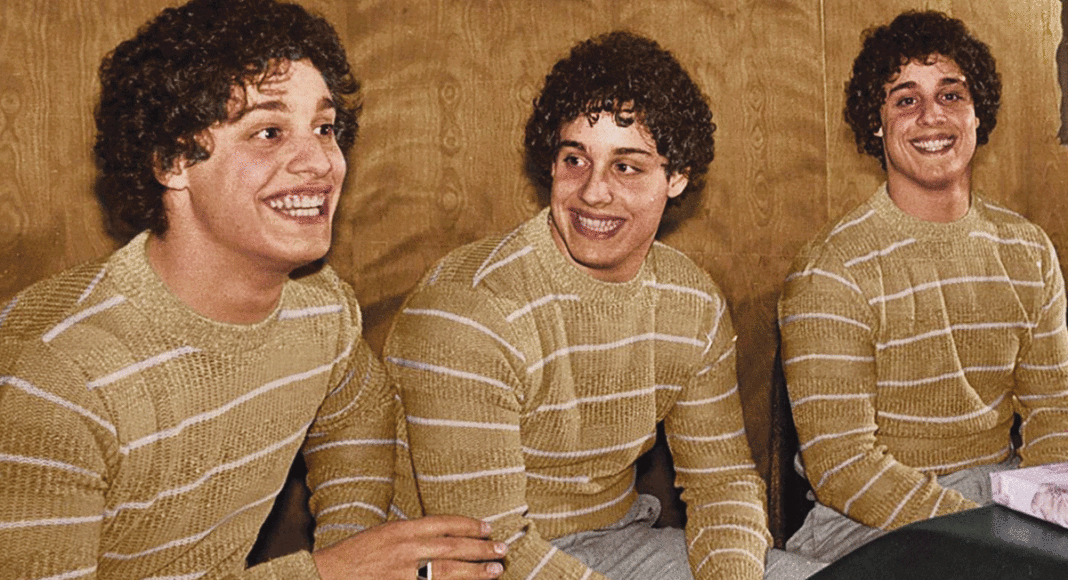Truth is definitely stranger than fiction—and a lot more sinister—in Three Identical Strangers. Filmmaker Tim Wardle’s engrossing documentary follows the true story of three young men who met by chance and discovered they were triplets, separated from each other and their birth mother as infants. None of them had any idea that the other two existed. How this happened—and the darker question of why—makes Wardle’s movie as gripping as any thriller.
As in fiction, we begin with a single protagonist whose adventures draw us into a larger story. In 1980, on his very first day of community college in the Catskills, 19-year-old Bobby Shafran couldn’t figure out why people he’d never seen before kept greeting him so warmly. Looking back, the adult Bobby recalls, he just thought it must be a friendly place. The weird thing was, everyone kept calling him “Eddy.”
On a hunch, one of his astonished fellow students asked Bobby if he was adopted, which he was. This student also knew the mysterious Eddy Galland, who was also adopted, and the two men took a two-hour drive to Long Island to meet him. “The door opened,” Bobby recalls, “and there was me, standing there.” The two strangers had the same curly hair, the same wide, toothy grin, the same build—and the same birthdate, at the same hospital. They were identical twins.
The human-interest story about the twins who found each other by sheer chance got some press in the local tabloids, and that’s when things got even more bizarre. David Kellman, a student at Queens College, saw a newspaper story about the twins, and recognized his own face—and his birthdate. Also raised by adoptive parents, David called the Gallands and reached Eddy’s mom. “Oh my god,” she remembers thinking, “They’re coming out of the woodwork!”
Using archival footage and some reenactment, this first section of the movie is played for larky good cheer, as the ingratiating triplets, now inseparable, make the rounds of talk shows and nightclubs, coasting along on the fumes of their amazing story and sudden celebrity. In time, they even open a NYC restaurant together, called—what else—Triplets.
But things begin to take a darker turn when all three sets of adoptive parents—none of whom was ever told about the other two boys—-go en masse to visit the adoption agency, Louise Wise Services, to get some answers as to why the babies were split up. Besides appearance and mannerisms, what the triplets have in common is that each was raised in a household with one other adopted sibling. Each one also vaguely remembers regular visits from strangers when he was a small child who gave him tests and filmed his play. And was it sheer coincidence that the boys were placed in such a cross-section of economic households—one working-class, one middle-class, and one well-to-do?
But nothing in this story is coincidental. While the agency’s so-called answers to the parents are “elusive,” we learn that major players included an Austrian geneticist, two of his research assistants (one slightly less ethically challenged than the other, in retrospect), and a journalist writing a story for The New Yorker whose research confirms that all three boys and their adoptive families—without their knowledge or consent—were part of a scientific study that went on for decades. But the study was never published, and David goes online to discover the documents have been sealed in a vault at Yale until 2066.
As each new revelation is unearthed, Wardle keeps his focus on the long-term effects on the triplets themselves. (As babies, their adoptive mothers report, each boy went through a head-banging phase from being separated from each other at such an early age.) Even their reunion is ultimately haunted by tragedy.
None of these participants knew they were in an experiment; they thought they were having lives. The callous indifference of the researchers and their enablers is chilling.
THREE IDENTICAL STRANGERS
*** (out of four)
With Eddy Galland, David Kellman, and Robert Shafran. Directed by Tim Wardle. A Neon release. Rated PG-13. 96 minutes.












